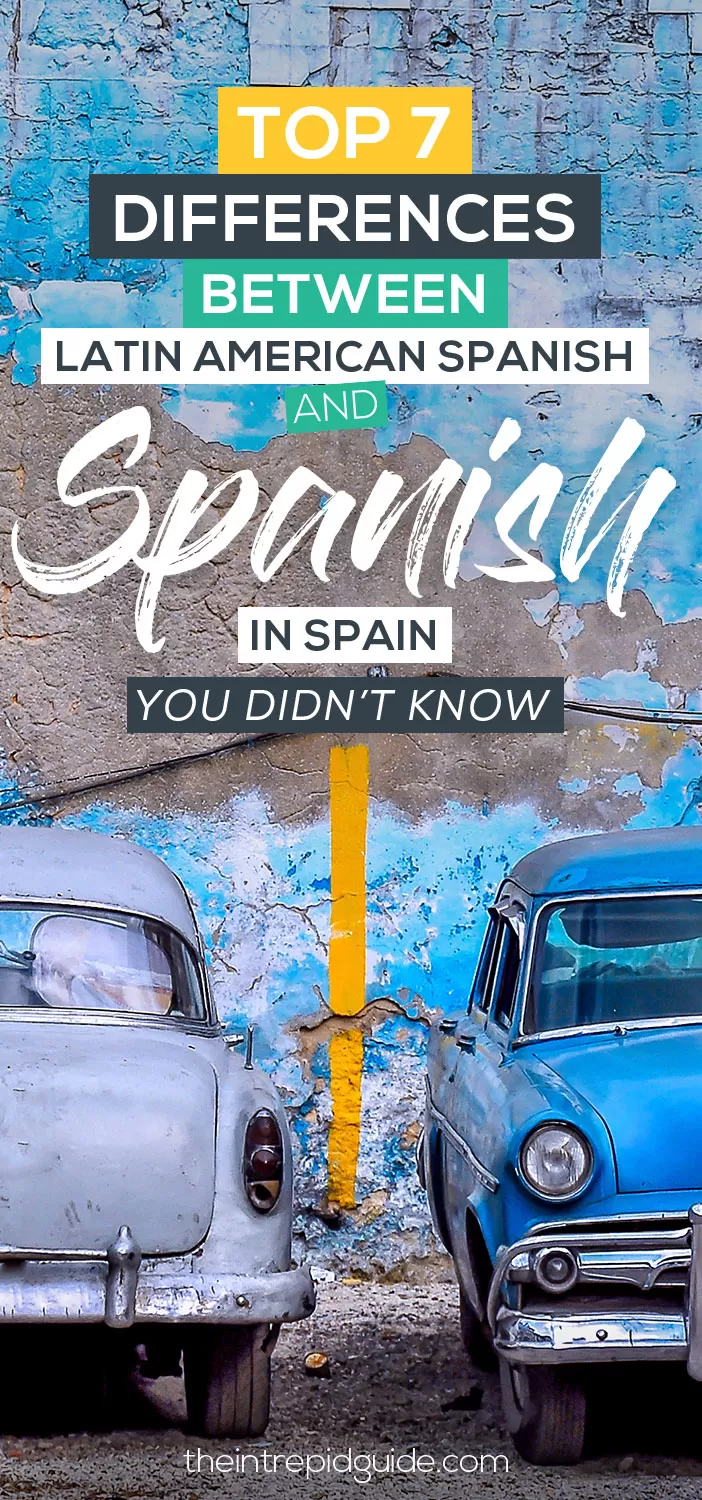There is Spain Spanish and Latin American Spanish, but what’s the difference? More than you think! From grammar and vocabulary to pronunciation, here are the major differences between the Spanish spoken in Spain and Latin American Spanish that you probably didn’t know about.
Want to learn Spanish before going to Latin America? It’s important to know that there are differences between European Spanish and the Spanish spoken in Latin America. To help me explain the nuances and differences between Spain Spanish and Latin American Spanish, I’ve asked my lovely friends May and Jim from Spanish and Go, experts in the Spanish language, to share their knowledge on the subject. If you’re interested in learning European or Latin American Spanish, check out my Intrepid Spanish course which focuses on teaching Spanish through real-world practical conversations for travellers.
But first…
What is the correct term for the different types of Spanish?
The Spanish spoken in Spain is called Castilian. The term actually refers to the province of Castile located in central Spain where it is believed that the Spanish language originated from. In Spain, Castilian Spanish is called Castellano, and the term is often used synonymously with “Spanish language”.
For those who speak Spanish in Latin America, this is simply referred to as Latin American Spanish. Easy!
Where is Latin American Spanish spoken?
Way back in the 15th-century, the Spanish conquistadors began to colonize the Americas to spread the word of god and gather precious metals. With their arrival came their language, Spanish, which began to spread all over the region.
Spanish is now spoken in some 16 countries in the Americas and on three islands in the Caribbean. In the Americas, Spanish is spoken in Argentina, Bolivia, Chile, Colombia, Costa Rica, Ecuador, El Salvador, Guatemala, Honduras, Mexico, Nicaragua, Panama, Paraguay, Peru, Uruguay, and Venezuela. Then, in the Caribbean, Spanish is spoken in Cuba, The Dominican Republic, and Puerto Rico.
Why are there different kinds of Spanish?
Much like how the Afrikaans evolved from Dutch after the Dutch colonised South Africa, and how Americans say ‘Fall’ while British English speakers still say ‘Autumn’, so too are their differences between Castilian and the Spanish which evolved in Latin America.
A linguist called Marckwardt calls this process the “colonial lag”, where the current state of a language spoken in new colonies does not evolve in the same way as the language in its country of origin.
So, the question is…
How different is Spain Spanish and Latin American Spanish?
There are a few notable differences between European/Castilian and Latin American Spanish. This includes the use of niceties such as when to use the formal “you,”, variations in pronunciation, differences in slang, and the use of vosotros (you – plural). Which we will dive into a little bit later.
Besides the very obvious differences, the Spanish language stays practically the same all over the world thanks to the RAE – La Real Academia de la Lengua Española (The Royal Academy of the Spanish Language) – which is Spain’s official institution in charge of promoting linguistic unity and to ensure the stability of the Spanish language within all territories where Spanish is spoken. Pretty cool, huh?
How well do European Spanish and Latin American Spanish speakers understand each other?
To understand the differences that exist between Castilian and Latin American Spanish, think of an American speaking English with a Brit, Irish, an Australian. There are some differences, sure, but nothing major. The same thing happens when someone from Spain visits Latin America or when someone from Argentina goes to Spain.
Aside from the use of slang and certain Spanish idioms, essentially all variations of Spanish are mutually understood worldwide.
However, it can be tricky to grasp the speed and intonation of the different accents at first, but after a few days tyou’ll have no trouble understanding each other.
This happened to May and Jim in Puerto Rico. May was born and raised in Mexico, and Jim speak Mexican Spanish fluently.
The first two or three days we spent on the island, Puerto Rican, the Spanish spoken there sounded like a whole new language. Boricuas (or Puerto Ricans) speak fast!
But after a couple of days we got used to the sounds and rhythm of Puerto Rican Spanish. We spent over a month around the island and we never had any problems communicating with the locals.
Some vocabulary was different, but it was easy to understand the meaning of most new words by context. For example, driving around the island we often saw signs of “Gomeras”. In Mexico, a “goma” is an eraser or bubble gum, so seeing “Gomeras” everywhere was odd until we noticed that there was always a bunch of car tires under the signs. So, we learned that “Gomera” in Puerto Rico is what in Mexico we call “Llantera”, a place where you can get your car’s tires changed.
If, for example, you’re learning Colombian Spanish and want to visit another Spanish-speaking country, doing a little research ahead of time will do wonders. Look up local slang and find any major vocabulary differences, this will help you hit the ground running once you arrive.
You’ll be relieved to know that the grammar generally stays the same for all Spanish-speaking countries.
Want to have fun whilst learning European Spanish, Latin American Spanish or Argentinian Spanish? Struggling to find decent Spanish language resources available? I recommend getting uTalk. Available as a desktop site and app, uTalk is awesome for learning key words and phrases in Spanish (either in European, Latin American, or Argentinian Spanish), especially if you want to use it for travel purposes. It’s great for beginners getting started in a language and invaluable for intermediates looking to fill in gaps in their vocabulary and pronunciation.
What I love most about uTalk is that you can jump around their extensive library of topics and choose what you want to learn, when you want, and at your own pace. Because I believe in uTalk so much, I reached out to them and we’ve teamed up to offer you an exclusive 30% OFF reader discount across all of uTalk’s 140 languages! This offer isn’t available anywhere else! Click here to claim your exclusive 30% discount in European Spanish, Latin American Spanish here,and Argentinian Spanish here.
What are the main differences between the Castilian and Latin American Spanish?
Here are the top 7 differences between Spain Spanish and Latin American Spanish.
1. Vosotros / Ustedes
Spaniards (i.e people from Spain) use the word ‘vosotros’ (you – plural) when addressing a group of people in a casual setting. For example, when speaking to a group of friends in Spain you might say ‘Vosotros sois mis mejores amigos.’ Whereas in Latin America you would say ‘Ustedes son mis mejores amigos.’ (You all are my best friends).
2. Tú / Vos
‘Vos’ (you – singular) is used predominantly in Argentina and Uruguay, but it’s also present in other Latin American Countries like Bolivia, Chile and Guatemala.
Spaniards, Mexicans and other Latin American’s use ‘tú’ when talking to a friend or when addressing someone informally. If you want to ask ‘¿Tú quieres ir a la fiesta?’ (Do you want to go to the party?) in some parts of Argentina, Uruguay, Bolivia, Chile, and Guatemala you would need to use ‘vos’, ‘¿Vos querés ir a la fiesta?’
When and How to Use Usted in Spanish [Tú vs Usted / Informal vs Formal]
3. Past perfect / Simple past
In European/Castilian Spanish it’s more common to hear people using the past perfect tense when describing recent actions, for example, ‘Me he quedado en casa hoy’ (I stayed home today). However, in Latin America, the simple past tense is preferred in these kinds of situations, so it would be ‘Me quedé en casa hoy’.
4. Vocabulary
The main and biggest differences between European/Castilian Spanish and Latin American Spanish and all the countries within it are related to vocabulary.
Here are a few of the most common words that are more commonly used in European/Castilian Spanish and their equivalents in Latin American Spanish.
- Móvil – Celular – (Mobile phone)
- Ordenador – Computadora (Computer)
- Automovil – Carro o Coche (Car)
- Torta – Pastel (Cake)
- Zumo – Jugo (Juice)
- Patata – papa (Potato)
- Gafas – Lentes (Glasses)
5. Pronounce z and c sound like ‘th’
Another major difference between Spanish in Spain and Latin American Spanish is the pronunciation of the letter ‘z’. For most Spaniards, ‘z’ (when it comes before any vowel) is pronounced like ‘th’ in English. In Latin American Spanish ‘z’ is always pronounced like an ‘s’.
Something similar happens with the letter ‘c’ in Spain Spanish. When there’s a ‘c’ before an ‘i’ or an ‘e’, the sound of the letter ‘c’ changes to the same ‘th’ sound in English. For example, in Spain the phrase ‘Cinco cervezas’ (five beers) would be pronounced ‘thin-co ther-ve-thas’ but in Latin America, you’d hear ‘sin-co ser-ve-sas’.
6. Pronounce Ll like ‘sh’
Argentinians pronounce. ‘ll’ like the ‘sh’ sound in English. So, the word ‘lloviendo’ (raining) in Argentina sounds more like ‘/sho-vien-do/’
7. Dropping final sounds
Another big difference between the pronunciation of Spain Spanish and Latin American Spanish is the latter often drops the letter ‘s’ from some words. This is especially true when it comes at the end of the word. For example, in Venezuela, Chile, Cuba, Dominican Republic and Puerto Rico the word ‘vamos’ (let’s go/we go) sounds more like ‘vamo’.
Another sound they tend to drop in some Latin American countries is the letter ‘d’ in the last syllable of a word. So, instead of ‘Coco rallado’ (shredded coconut), they say ‘Coco rallao’.
Dropping sounds at the end of words can be heard in specific parts on Spain too but it is far more noticeable in the Caribbean and some countries in South America.
How important it is to know Spanish when travelling around Latin America?
Do the locals speak English in Latin America? Yes, but…some English is spoken in areas where there is a lot of tourism. If you want to immerse yourself in the true culture of the places you visit, you have to at least know the basics of Spanish.
In smaller cities and towns it can be hard to find people who speak English, so it pays to speak the language. You’ll certainly earn more respect from the locals if you at least try. Make sure you get my free Latin American Spanish phrase guide.
Learn Spanish with my 80/20 method, with Intrepid Spanish!
Travelling to Spain or Latin America? Don’t be treated like a tourist! Live your best travel experiences and learn Spanish for less than the cost of eating at a tourist trap restaurant or a taxi driver who has “taken you for a ride”. In addition to my free Spanish travel phrase guide, I’ve made it even easier for you to master the Spanish language so you can create lifelong memories as you mingle with locals, get local tips, avoid tourist traps, and make new friends. Join my popular Spanish course here.
Here’s what my students are saying:
I really enjoyed the Master Italian for Travel FAST course, it certainly exceeded my expectations. The learning methodology is great, and easy to follow and found that I progressed much faster in the last 4 weeks than I ever did on my own or using other language apps. Grazie mille Michele, I can’t wait until I can put my new skills into action! – Roma Small
Click here for instant access!
Like it? Pin it for later!
Want to know more about learning languages? Start here!
- 17 Embarrassingly Funny False Friends in Spanish to Avoid
- 25 Unforgettably Hilarious Spanish Expressions & Idioms [Infographic]
- Top Language Learning Resources You Should Use
- 11 Life-Changing Reasons Why You Should Learn a Language
- 42 beautiful Inspirational Quotes for Language Learners
- Language learning tips: 11 Polyglots Reveal The Secrets of Their Success
- Top 10 Best Ways to Learn a Language Better and Faster
Over to you!
Which of these differences between Castilian and Latin American Spanish surprised you the most? Are you planning a trip to Latin America or Spain? Let me know using the comments section below or join me on social media to start a conversation.
Thanks for reading and I hope you enjoyed this post.
Like what you see? Subscribe using the form below to have all of my posts delivered directly to your email.





2 comments
While you only compared “American” Spanish to Castilian, you did not consider Andaluz (spoken in Andalucia). I spent 2 years in Andalucia many years ago and became relatively fluent at the time. The Spanish I had learn from the texts was Castilian, but I soon discovered that words like “cinco” , pronounced like “thinko” in Madrid was pronounced “sinko” in Andalucia. The “Z” would be a mixed bag; at the end of a word, it was typically pronounced “th”, e.g., Cadiz, Jerez, Andaluz, etc. but elsewhere in a word, it was pronounced closer to “s”. Then there was the a “Y” and the “ll”, both pronounced like a soft “j” or “zh” (like como se zhama or zho voy). Then there was “se tragan las ess” and the “d” dropped from past participle words like cansado to “cansao”.
There are probably others that I no longer remember after 60 years, but I also picked up some Catalan from friends from Valencia and “Gitano” (from some Gypsy friends). I still have some great memories of my time there and the people I met in spite of it being a dictatorship at the time under Franco and his “Guardia Civil”.
Thank you for sharing these insights Bob 🙂